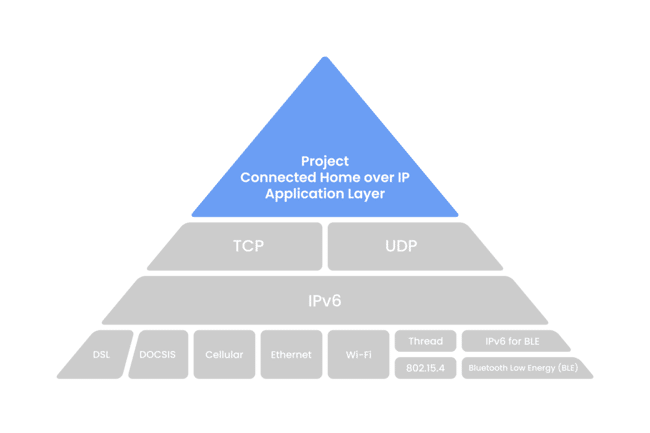BLOG
What You Need to Know About Project Connected Home Over IP
When we buy a smart home device, take it home, and plug it in, we expect it to work out of the box, especially when it comes to connecting to other devices on our local network. From a consumer’s perspective, it seems obvious that we should be able to control devices like smart lights, smart locks, or IoT fish tanks with our voice assistant, or we should be able to build automation routines like setting our lights to automatically turn on when we open the front door in the evening.
The problem is that it just doesn’t work out this way.
One of the major hurdles to widespread smart home device adoption is that current devices run in fragmented silos on countless communication protocols, many of which are proprietary and incapable of talking to anything outside of their little bubble. Especially since we’re working towards a future of ubiquitous computing, in which connected devices provide a seamless user experience to make our lives easier, the industry is starting to realize that the status quo simply isn’t going to cut it.
Enter Project CHIP.
What is Project CHIP?
Short for “Connected Home over IP,” Project CHIP is a work group that “plans to develop and promote the adoption of a new, royalty-free connectivity standard to increase compatibility among smart home products, with security as a fundamental design tenant.” This partnership includes Amazon, Apple, Google, the Zigbee Alliance, and dozens of other companies.

Image credit: Project CHIP
Since their initial announcement in late 2019, CHIP has gained a fair amount of steam and attracted more partners and attention. While we’re still waiting for the full details, especially all the juicy technical bits, there are a few things that we do know at this point.
First, CHIP is built on top of Internet Protocol (IP) using a standard TCP/UDP and IPv6 stack. They’re not setting out to reinvent the wheel, and it’s a smart move to base this new protocol on something that’s already proven to scale up to the world wide web. What’s unique is that CHIP is looping in a diverse set of networking technologies, including but not limited to Ethernet, Wi-Fi, Bluetooth, Cellular, Thread, and, of course, Zigbee.
What Are the Benefits of Project CHIP?
Another major draw to Project CHIP is that it’s entirely open source. This means anyone can view, use, or edit the code from their GitHub repo, and this brings a few distinct advantages. First, open source software (OSS) is often higher quality because anyone can critique it. Second, this encourages buy-in from developers. Given the tech giants’ involvement in this project, it’s reasonable for smaller companies and independent developers to worry about them having an outsized influence. By open-sourcing this project, it fosters trust in the community and encourages more widespread adoption.
Basically, CHIP is an umbrella that pulls together everything in a smart home system. Smart home devices need to talk to each other, to our mobile phones, and to the cloud. Nobody wants to use six different apps to configure their smart home, and nobody wants to have to install a bunch of different cloud gateways on their network.
If CHIP delivers on its promises, we’ll be one step closer to living in homes that we can truly call smart.
How Will Very Work with Project CHIP?
While Very isn’t currently part of the Project CHIP working group, we’re keeping a close eye on it because we understand its potential. The word is getting out, and people see the overall appeal. We recognize our clients’ perspective that easily integrating a new device into a larger ecosystem brings huge value to that device. As leaders in the IoT industry, we will continue to stay at the technological cutting-edge so long as it brings an advantage to our clients or their customers.
The idea of a ubiquitous smart home network has been a dream for a long, long time. And while that’s the stated goal of Project CHIP, the implications may be even more far reaching than that. If these developers can create a solution that’s highly scalable, lightweight, and easily applicable, then we’ll be on our way to more commercial applications like IIoT, and this is even a step towards smart cities.
One of the most exciting things about working in technology is that we sometimes get to look the future right in the face. This is one of those moments.
Looking for assistance to take your smart home product to the next level? Contact us today.











